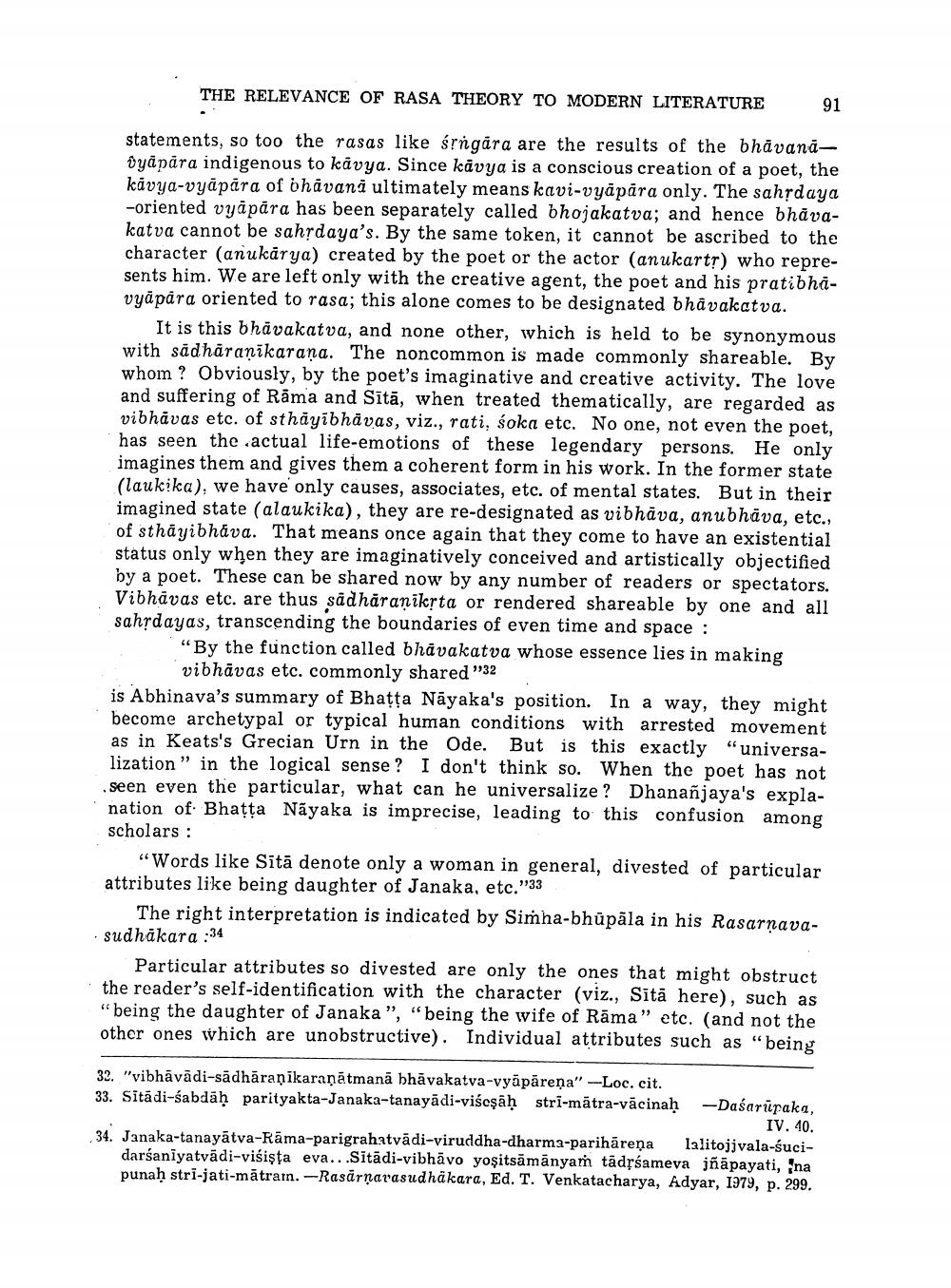________________
THE RELEVANCE OF RASA THEORY TO MODERN LITERATURE
91
statements, so too the rasas like srngära are the results of the bhāvanāoyapära indigenous to kavya. Since kavya is a conscious creation of a poet, the kavya-vyāpara of bhāvani ultimately means kavi-vyāpāra only. The sahȚdaya -oriented vyāpāra has been separately called bhojakatva; and hence bhāvakatva cannot be sahȚdaya's. By the same token, it cannot be ascribed to the character (anukārya) created by the poet or the actor (anukarts) who represents him. We are left only with the creative agent, the poet and his pratibhavyäpara oriented to rasa; this alone comes to be designated bhävakatva.
It is this bhāvakatva, and none other, which is held to be synonymous with sādharanikarana. The noncommon is made commonly shareable. By whom? Obviously, by the poet's imaginative and creative activity. The love and suffering of Rāma and Sītā, when treated thematically, are regarded as vibhāvas etc. of sthayibhāvas, viz., rati, śoka etc. No one, not even the poet, has seen the actual life-emotions of these legendary persons. He only imagines them and gives them a coherent form in his work. In the former state (laukika), we have only causes, associates, etc. of mental states. But in their imagined state (alaukika), they are re-designated as vibhāva, anubhāva, etc., of sthāyibhāva. That means once again that they come to have an existential status only when they are imaginatively conceived and artistically objectified by a poet. These can be shared now by any number of readers or spectators. Vibhāvas etc. are thus sådhāranikȚta or rendered shareable by one and all sahşdayas, transcending the boundaries of even time and space :
"By the function called bhāvakatva whose essence lies in making
vibhāvas etc. commonly shared "32 is Abhinava's summary of Bhatta Nāyaka's position. In a way, they might become archetypal or typical human conditions with arrested movement as in Keats's Grecian Urn in the Ode. But is this exactly "universalization" in the logical sense? I don't think so. When the poet has not seen even the particular, what can he universalize? Dhanañjaya's explanation of Bhațța Nãyaka is imprecise, leading to this confusion among scholars :
“Words like Sītā denote only a woman in general, divested of particular attributes like being daughter of Janaka, etc."33
The right interpretation is indicated by Simha-bhūpāla in his Rasarnavasudhākara :34
Particular attributes so divested are only the ones that might obstruct the reader's self-identification with the character (viz., Sītā here), such as "being the daughter of Janaka ", "being the wife of Rāma” etc. (and not the other ones which are unobstructive). Individual attributes such as "being
32. "vibhāvādi-sādhāraņikaraņātmanā bhāvakatva-vyāpāreņa" -Loc. cit. 33. Sītādi-sabdāḥ parityakta-Janaka-tanayādi-viścșāḥ stri-mātra-vācinaḥ -Dasarūraka,
IV. 40. 34. Janaka-tanayātva-Rāma-parigrahatvādi-viruddha-dharma-parihāreņa lalitojjvala-suci
darśanīyatvādi-višişta eva...Sitādi-vibhāvo yoşitsāmānyaṁ tādṛśameva jñāpayati, na punaḥ stri-jati-mātrain. -Rasārņarasudhakara, Ed. T. Venkatacharya, Adyar, 1979, p. 299.




